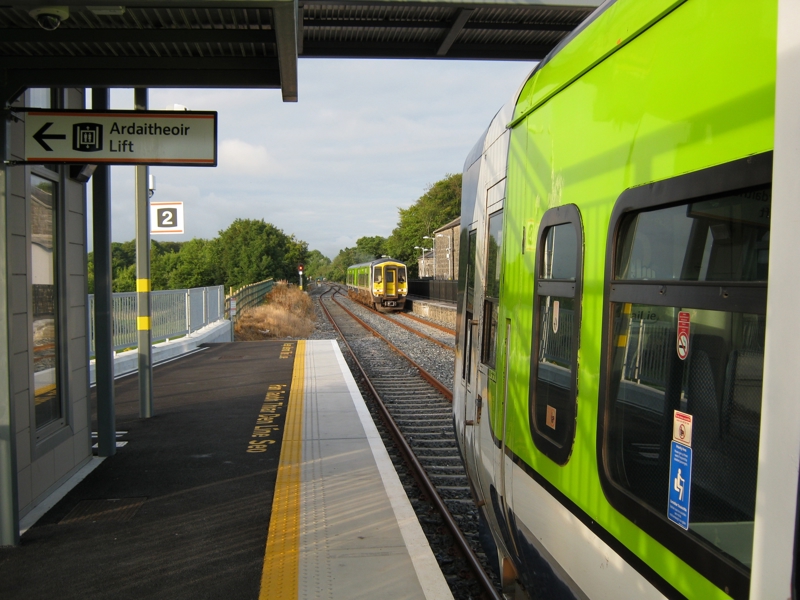Ireland’s All-Island Strategic Rail Review has ambitious designs to transform and develop the countries’ rail network. Philip Haigh examines the facts and figures.
In this article:
Ireland’s All-Island Strategic Rail Review has ambitious designs to transform and develop the countries’ rail network. Philip Haigh examines the facts and figures.
In this article:
- Ireland plans to reopen lines or open new lines including for three airports
- Widespread electrification could cost up to £6bn
- 50% faster journey times
- 25% more people living within three miles of a station
 Rail passengers in Ireland could treble in number by 2050 if the two governments deliver the recommendations of their All-Island Strategic Rail Review.
Rail passengers in Ireland could treble in number by 2050 if the two governments deliver the recommendations of their All-Island Strategic Rail Review.
That would lift today’s figure of 65 million to more than 180 million, the final version of the review noted as it was published in July.
The review suggests radical change that includes reopening lines, most notably from Portadown to Mullingar via Monaghan (£1.2 billion, reversing a 1957 closure) and to Londonderry via Omagh (£2.8bn including electrification, it closed in 1964), as well as widespread electrification and line speed improvements.
Such work comes with a cost. The review estimates a total bill of £29bn-£31bn (€35-€37bn) in 2023 prices, working from earlier estimates that included a 56% optimism bias. Splitting this evenly across 25 years gives annual spending for Ireland of €1bn and for Northern Ireland of £0.31bn.
Noting close co-operation across the border, Irish Transport Minister Eamon Ryan said: “Rail not only allows us to carry more people and freight in a more sustainable way, it is also the great connector, enabling greater regional accessibility and balanced regional development.”
Northern Ireland Infrastructure Minister John O’Dowd commented: “This publication brings us to a new chapter where we can shape a better future for everyone by decarbonising key services and investing in climate adaptation measures, while at the same time supporting economic productivity through projects, policy and legislation. Getting infrastructure right, and investing in it accordingly, can create the foundations for better rural and urban communities.”
The report places rail as the backbone of public transport, which should allow for the island’s growing population. However, it acknowledges that the current rail network has significant gaps in coverage, runs trains at low frequencies, has little electrification, poor and inconsistent station access, and integrates poorly with other modes in cities such as Dublin.
It adds that no major Irish airport has a rail service. Therefore, the review recommends a new line from Lisburn to Antrim via Belfast Airport, a new line from Limerick to Shannon Airport, and a new branch from Clongriffin to serve Dublin Airport.
Reopened lines include Athenry-Tuam-Claremorris (£500 million), which would complete the Western Rail Corridor, and a link from Waterford to Wexford (£550m) in south-east Ireland (they’re about an hour apart by road but over six hours by rail, routed via Dublin).
Both rail routes remain intact with track in place. This includes the girder bridge over the River Barrow outside Waterford, which at 650 metres is Ireland’s longest rail bridge. It lost its daily Rosslare-Waterford and return service in 2010 because of low passenger numbers.
Both lines could now be renewed in the way that Iarnród Éireann is currently reopening the branch from Limerick to Foynes.
With these lines in place, Ireland would create a network that almost encircles the island, in addition to its routes radiating from its capitals of Dublin and Belfast. The only missing part would be in the North West, with only radial routes serving Ballina, Sligo and Londonderry.
The review explains that challenging terrain and relatively low populations meant that rail was not suitable to link this area.
Yet it’s had rail in the past. The line from Claremorris (south of Ballina) to Cooloney (near Sligo) remains intact with track, although it closed in 1975. From there, trains ran via Enniskillen to Omagh, but ceased in 1957 as the government in Belfast shut this cross-border route.
In part, this strategic review recommends putting back some of what Ireland once had.
Its rail network peaked in the 1920s at around 3,400 miles, making it “one of the densest networks in the world” according to the review.
But it shrank substantially between the 1930s and 1970s to give today’s 1,400 miles (1,200 miles in Ireland and 200 miles in Northern Ireland).
The decline came not only with the rise of motor vehicles, but also because of the island’s separation into two jurisdictions in the 1920s, which introduced cross-border customs controls and disrupted trade and travel. Hence the lack of a railway through Armagh, Monaghan and Cavan today, which the review wants returned.
Another potential reopening is Mullingar to Athlone. It had trains until the late 1980s, but in 2015 had a cycle path installed along one side of its double-track formation. Nevertheless, the review attaches a £400m tag to reopening its 25 miles.
While new or reopened lines might catch the headlines, the review also proposes widespread electrification.
If fully implemented, then the review estimates that wiring the core route from Dublin to Cork would cost £1.4bn. Electrifying the lines to other cities from this core route would cost another £1bn to reach Galway, £700m to Waterford, and £200m to Limerick.
The cross-border route to Belfast would be wired (£1.7bn, including a new line from Drogheda to Dublin to avoid suburban services), as would the proposed new route though Omagh.
The bill for this electrification could reach £6bn, although the review’s estimates bundle some double-tracking upgrades into this total.
The review admits that wiring on this scale will take time and investment, and that it needs a rolling programme with long-term certainty rather than a stop-start approach which it says has pushed costs up elsewhere.
It suggests using hybrid trains as an interim option, but doesn’t really answer the problem posed by Dublin’s suburban network, which is wired for direct current (DC) operation instead of the alternating current (AC) that the review puts forward for long-distance, higher-speed lines.
The review recommends higher speeds on existing lines, suggesting that 125mph running is the optimum. This will need significant upgrades to signalling, track, level crossings and rolling stock.
But it dismisses the idea of 186mph high-speed services, as seen in continental Europe, saying that costs would significantly outweigh benefits.
Short-term service improvements can come with improved frequencies, thanks (the review says) to planned procurement of extra rolling stock. But beyond this, the network needs more capacity in the form of extra tracks, upgraded junctions, and more platforms at stations.
Should Ireland’s two jurisdictions deliver all these recommendations, then the result could be that 80% of train miles run with electric traction, journey times could be up to 50% quicker, and 700,000 more people would be living within three miles of a station (up 25% from today).
The review calculates an overall cost-to-benefit ratio of 1.1, which it says shows that its recommendations are economically feasible. It adds that further work will be needed to test each improvement, to decide on funding.
Funding also needs political will to deliver the recommendations of this review. Ministers can talk, but it’s their actions that will count.
Strategic goals
- Contribute to decarbonisation.
- Improve connectivity between the island’s major cities.
- Enhance regional and rural accessibility.
- Encourage sustainable mobility.
- Foster economic activity.
- Achieve economic and financial feasibility.
Source: All-Island Strategic Rail Review.
All Island Strategic Rail Review recommendations
Decarbonisation
- Develop and implement an All-Island Rail Decarbonisation Strategy that includes an electrified inter-city network.
- Develop plans to invest in skills, supply chains, and rolling stock to deliver decarbonisation.
- Procure hybrid and electric rolling stock in the medium term.
Inter-city
- Upgrade the cross-country rail network to a dual-track railway (and four-track in places) and increase service frequencies.
- Upgrade the core inter-city railway network to top speeds of 125mph (200kph).
- Develop short sections of new railways on congested corridors.
- Develop a cross-Dublin solution.
Regional and rural
- Provide more direct services between Ireland’s west and south coasts.
- Ensure regional and rural lines have at least one train per two hours.
- Increase line speeds to at least 75mph (120kph).
- Upgrade Limerick Junction and the Limerick Junction-Waterford line.
- Reinstate the Western Rail Corridor railway between Claremorris and Athenry.
- Extend the railway into Tyrone, Londonderry and Donegal.
- Reinstate the South Wexford Railway.
- Develop the railway to boost connectivity in the North Midlands.
- Integrate bus service and rail service timetables to connect communities where direct rail access proves to be unviable.
Cities
- Connect Dublin, Belfast International and Shannon Airport to the railway and improve existing rail-airport connections.
- Extend double-tracking in the Belfast area.
- Segregate long-distance/fast services from stopping services.
- Explore the case for developing new stations in the Belfast, Cork, Londonderry and Limerick–Shannon city regions.
Freight
- Develop a sustainable solution for first-mile-last-mile rail access for Dublin Port.
- Reduce track access charges for freight.
- Strengthen rail connectivity to the island’s busiest ports.
- Develop a network of inland terminals close to major cities on the rail network.
Customer experience
- Continue to invest in initiatives that deliver a seamless customer journey.
- Continue to benchmark and monitor service quality and deliver continuous improvement.
- Ensure future rolling stock specifications are aligned to the infrastructure-led interventions outlined in this Review.
- Invest in improving integration within rail and between rail and other transport options.
- Deliver ‘clock-face’ timetable calling patterns.
- Develop cross-border structures to improve the effectiveness of cross-border infrastructure and rail service planning.
- Invest in a rolling programme of accessibility improvements, including step-free access.
- Review and update the All-Island Strategic Rail Review once a decade, taking account of latest policies and developments.
Source: All-Island Strategic Rail Review.
Login to continue reading
Or register with RAIL to keep up-to-date with the latest news, insight and opinion.


















Login to comment
Comments
No comments have been made yet.